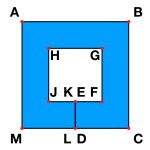Simple polygon

In geometry a simple polygon /ˈpɒlɪɡɒn/ is defined as a flat shape consisting of straight, non-intersecting line segments or "sides" that are joined pair-wise to form a closed path. If the sides intersect then the polygon is not simple. The qualifier "simple" is frequently omitted, with the above definition then being understood to define a polygon in general.
The definition given above ensures the following properties:
- A polygon encloses a region (called its interior) which always has a measurable area.
- The line segments that make-up a polygon (called sides or edges) meet only at their endpoints, called vertices (singular: vertex) or less formally "corners".
- Exactly two edges meet at each vertex.
- The number of edges always equals the number of vertices.
Two edges meeting at a corner are usually required to form an angle that is not straight (180°); otherwise, the collinear line segments will be considered parts of a single side.
Mathematicians typically use "polygon" to refer only to the shape made up by the line segments, not the enclosed region, however some may use "polygon" to refer to a plane figure that is bounded by a closed path, composed of a finite sequence of straight line segments (i.e., by a closed polygonal chain). According to the definition in use, this boundary may or may not form part of the polygon itself.[1]
Simple polygons are also called Jordan polygons, because the Jordan curve theorem can be used to prove that such a polygon divides the plane into two regions, the region inside it and the region outside it. A simple polygon in the plane is topologically equivalent to a circle and its interior is topologically equivalent to a disk.
Weakly simple polygon

If a closed polygonal chain embedded in the plane divides it into two regions one of which is topologically equivalent to a disk, then the chain is called a weakly simple polygon.[2] Informally, a weakly simple polygon is a polygon in which some sides can "touch" but cannot "cross over".
In the image on the left, ABCDEFGHJKLM is a weakly simple polygon with the color blue marking its interior.
In a more general definition of weakly simple polygons, they are the limits of sequences of simple polygons of the same combinatorial type, with the convergence under the Hausdorff metric. The "interior" can be empty. For example, referring to the image above, the polygonal chain ABCBA is a weakly simple polygon: it may be viewed as the limit of "squeezing" of the polygon ABCFGHA.
Non-simple weakly simple polygons arise in computer graphics and CAD as a computer representation of polygonal regions with holes: for each hole a "cut" is created to connect it to an external boundary. Referring to the image above, ABCM is an external boundary of a planar region with a hole FGHJ. The cut ED connects the hole with the exterior and is traversed twice in the resulting weakly simple polygonal representation.
Computational problems
In computational geometry, several important computational tasks involve inputs in the form of a simple polygon; in each of these problems, the distinction between the interior and exterior is crucial in the problem definition.[3]
- Point in polygon testing involves determining, for a simple polygon P and a query point q, whether q lies interior to P.
- Simple formulae are known for computing polygon area; that is, the area of the interior of the polygon.
- Polygon triangulation: dividing a simple polygon into triangles. Although convex polygons are easy to triangulate, triangulating a general simple polygon is more difficult because we have to avoid adding edges that cross outside the polygon. Nevertheless, Bernard Chazelle showed in 1991 that any simple polygon with n vertices can be triangulated in Θ(n) time, which is optimal. The same algorithm may also be used for determining whether a closed polygonal chain forms a simple polygon.
- Polygon union: finding the simple polygon or polygons containing the area inside either of two simple polygons
- Polygon intersection: finding the simple polygon or polygons containing the area inside both of two simple polygons
- The convex hull of a simple polygon may be computed more efficiently than the complex hull of other types of inputs, such as the convex hull of a point set.
- Voronoi diagram of a simple polygon
- Medial axis/topological skeleton/straight skeleton of a simple polygon
- Offset curve of a simple polygon
- Polygon resizing
- Minkowski sum for simple polygons
See also
References
- ↑ Grünbaum, B.; Convex polytopes 2nd Ed, Springer, 2003
- ↑ Wolfgang Thomas, Pascal Weil (2007). STACS 2007: 24th Annual Symposium on Theoretical Aspects of Computer Science, Aachen, Germany, February 22-24, 2007, Proceedings (illustrated ed.). Springer. p. 177. ISBN 3540709177.
- ↑ The comp.graphics.algorithms FAQ, which lists solutions to mathematical problems with 2D and 3D polygons.